Nerchinsk agreement. The first world of Russia with China
By the second half of the XVII century. the development of Siberia by Russian industrialists and merchants was already in full swing. First of all, they were interested in furs, which was considered an extremely valuable commodity. However, the advancement into the depths of Siberia required the creation of stationary points where food bases could be organized for pioneers. After all, the delivery of food to Siberia at that time was almost impossible. Accordingly, there were settlements, whose inhabitants were engaged not only in hunting, but also in agriculture. There was a development of the Siberian lands. In 1649, the Russians entered the Amur region. Representatives of numerous Tungus-Manchu and Mongolian peoples lived here - Dauri, Ducher, Goguli, Achana.
Russian troops began to tax the weak Daurian and Ducherian principalities with a significant tribute. Local Aborigines could not resist the Russians militarily, therefore they were forced to pay tribute. But since the peoples of the Amur region were considered tributaries of the powerful Qing Empire, in the end this situation caused a very negative reaction from the Manchu rulers of China. Already in 1651, in Achansk town, which was captured by the Russian detachment E.P. Khabarova, a Qing punitive detachment under the command of Haise and Sifu was sent. However, the Cossacks managed to defeat the Manchu detachment. The advance of the Russians into the Far East continued. The next two decades went down in the history of the development of Eastern Siberia and the Far East as a period of constant battles between the Russian and Qing detachments, in which either the Russians or the Manchus won. Nevertheless, in 1666, the detachment of Nikifor Chernigovsky was able to begin rebuilding the Albazin fortress, and in 1670, an embassy was sent to Beijing, who managed to negotiate a ceasefire with the Manchus to approximate the "spheres of influence" in the Amur region. At the same time, the Russians refused to invade the Qing lands, while the Manchus refused to invade the Russian lands. In 1682, the Albazin Voivodeship was officially created, at the head of which the voivode was put, the emblem and seal of the voivodship were adopted. At the same time, the Qing leadership again preoccupied with the question of ousting Russians from the Amur lands, which the Manchus considered their original possessions. Manchu officials Pengchun and Lantan led an armed detachment aimed at ousting Russians.
In November, 1682, Lantan, with a small reconnaissance detachment, visited Albazin, conducting reconnaissance of its fortifications. He explained to the Russians his presence in the vicinity of the prison with the hunt for deer. Upon his return, Lantany reported to the leadership that the wooden fortifications of the Albazinsky prison were weak and there were no particular obstacles for the military operation to oust the Russians from there. In March 1683, the emperor Kangxi issued an order to prepare for a military operation in the Amur region. In 1683-1684 Manchu detachments periodically raided the Albazin environs, forcing the governor to send out a detachment of servicemen from Western Siberia to strengthen the fortress garrison. But given the specifics of the then transport connection, the detachment moved extremely slowly. Manchus took advantage of this.
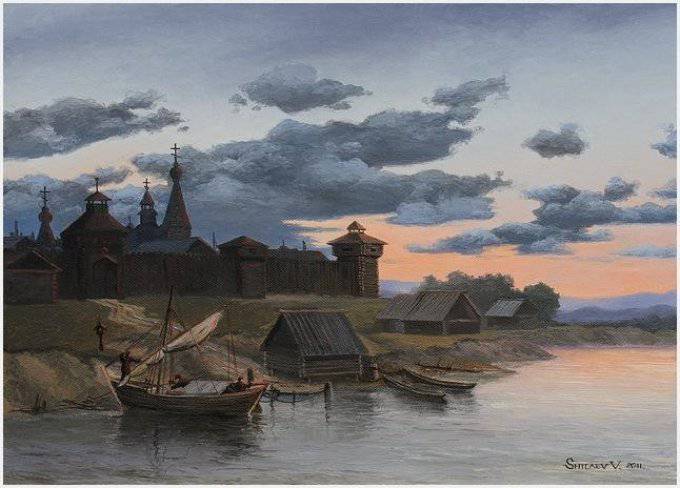
In the early summer of 1685, the Qing army of 3-5 thousand people began to advance towards Albazin. Manchurians moved on river vessels flotilla on the river Sungari. Approaching Albazin, the Manchus began the construction of siege structures and the deployment of artillery. By the way, the Qing army, which approached Albazin, was armed with at least 30 guns. The shelling of the fortress began. The wooden defenses of Albazin, which were built in anticipation of protection from the arrows of the local Tungus-Manchu aborigines, could not withstand artillery fire. The victims of the shelling were at least one hundred people from among the inhabitants of the fortress. On the morning of June 16, 1685, the Qing troops launched a general assault on the Albazin fortress.
It should be noted here that a detachment of 100 servicemen with 2 guns under the command of Governor Ivan Vlasov was assembled to help the Albazin garrison in Nerchinsk. Hurried and reinforcements from Western Siberia, led by Athanasius Bayton. But by the time the storming of the fortress reinforcements did not have time. In the end, the commander of the Albazin garrison, Aleksei Tolbuzin, the voivode, managed to agree with the Manchus on the withdrawal of the Russians from Albazin and the departure to Nerchinsk. 20 June 1685 The Albazinsky burg was handed over. However, the Manchus did not consolidate in Albazin - and this was their main mistake. Two months later, on August 27 of 1685, voboda Tolbuzin returned to Albazin with a detachment of 514 servicemen and 155 peasants and fishermen, who restored the fortress. The fortress defenses were significantly fortified, already from the calculation, so that the next time they could withstand artillery shelling. The construction of fortifications was led by Athanasius Beyton, a German who converted to Orthodoxy and Russian citizenship.
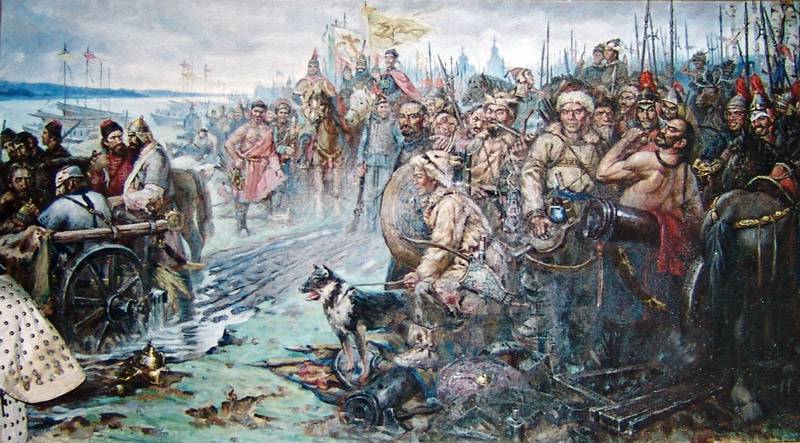
However, the restoration of Albazin was closely watched by the Manchus, whose garrison was stationed in the Aygun fortress not so far away. Soon, the Manchu detachments again began to attack the Russian settlers, who were cultivating the fields in the vicinity of Albazin. 17 April 1686, the emperor Kangxi ordered the commander of Lantan again to take Albazin, but this time not to leave him, but to turn him into a Manchurian fortress. 7 July 1686 of the Manchurian detachments appeared near Albazin, delivered by a river flotilla. As in the past year, the Manchus began an artillery bombardment of the town, but it did not give the desired results - the cores were stuck in earthen ramparts, prudently constructed by the defenders of the fortress. However, voivode Alexey Tolbuzin was killed during one of the attacks. The siege of the fortress dragged on and the Manchus even erected several dugouts, preparing to take the garrison to death. In October 1686, the Manchus made a new attempt to assault the fortress, but it also ended in failure. The siege continued. By this time, around 500 service people and peasants died in the fortress from scurvy, only 150 people survived, of which only 45 people were “on their feet”. But the garrison was not going to surrender.
When at the end of October, 1686, another Russian embassy arrived in Beijing, the emperor agreed to an armistice. 6 May 1687, the troops of Lantanya retreated from Albazin to 4 for a mile and a half, but continued to prevent the Russians from sowing the surrounding fields, as the Manchurian command hoped, by starvation, to get the fortress to surrender.
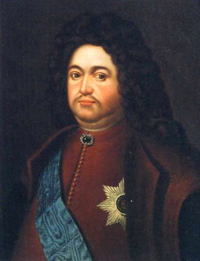
Meanwhile, even 26 January 1686, after the news of the first siege of Albazin, from Moscow to China was sent to the "great and plenipotentiary embassy." He was led by three officials - the steward Fedor Golovin (in the photo, the future Field Marshal and the closest associate of Peter the Great), the Irkutsk voivode Ivan Vlasov and the diak Simon Kornitsky. Fedor Golovin (1650-1706), who headed the embassy, was descended from a boyar family of the Khovrin-Golovins, and by the time of the Nerchinsk delegation was already quite an experienced statesman. No less tempted was Ivan Vlasov, a Greek who accepted Russian citizenship and served as commander in 1674 in various Siberian cities.
Accompanied by a retinue and a guard, the embassy moved across Russia to China. In the autumn of 1688, the embassy of Golovin arrived in Nerchinsk, where the Chinese emperor asked for negotiations.
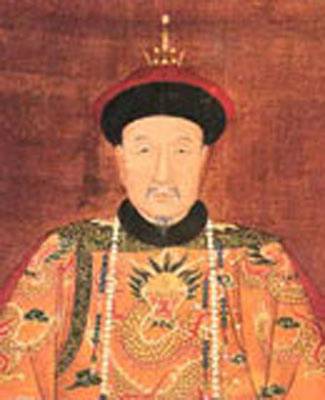 From the Manchurian side, an impressive embassy was also formed, headed by Prince Songgotu, the minister of the imperial court, who was in 1669-1679. Regent at the minor Kangxi and the de facto ruler of China, Tong Guegan - the uncle of the emperor and Lantan - the military leader who commanded the siege of Albazin. The head of the embassy, Prince Songotu (1636-1703), was brought by brother-in-law to Emperor Kangxi, who was married to the niece of the prince. A native of a noble Manchu family, Songgotu received a traditional Chinese education and was quite an experienced and far-sighted politician. When the emperor Kangxi matured, he removed the regent from power, but continued to treat him with sympathy, and therefore Songthot continued to play an important role in the foreign and domestic policies of the Qing empire.
From the Manchurian side, an impressive embassy was also formed, headed by Prince Songgotu, the minister of the imperial court, who was in 1669-1679. Regent at the minor Kangxi and the de facto ruler of China, Tong Guegan - the uncle of the emperor and Lantan - the military leader who commanded the siege of Albazin. The head of the embassy, Prince Songotu (1636-1703), was brought by brother-in-law to Emperor Kangxi, who was married to the niece of the prince. A native of a noble Manchu family, Songgotu received a traditional Chinese education and was quite an experienced and far-sighted politician. When the emperor Kangxi matured, he removed the regent from power, but continued to treat him with sympathy, and therefore Songthot continued to play an important role in the foreign and domestic policies of the Qing empire. Since the Russians did not know Chinese, and the Chinese did not speak Russian, the negotiations were to be conducted in Latin. For this, the Russian delegation included a translator from Latin, Andrei Belobotsky, and a Manchurian delegation included Spanish Jesuit Thomas Pereira and French Jesuit Jean-François Gerbillon.
The meeting of two delegations took place at the appointed place - on the field between the rivers Shilka and Nerchey, half a mile from Nerchinsk. The negotiations were held in Latin and began with the fact that the Russian ambassadors complained about the beginning of the Manchus of hostilities without declaring war. Manchurian ambassadors retorted that the Russians arbitrarily built Albazin. At the same time, representatives of the Qing Empire stressed that when Albazin was taken for the first time, the Manchus released the Russians whole and intact with the condition that they would not return, but after two months they returned again and rebuilt Albazin.
The Manchu side insisted that the Dahurian lands belong to the Qing empire by family law, since the time of Genghis Khan, who allegedly was the ancestor of the Manchu emperors. In turn, the Russian ambassadors argued that the Dauri had long recognized Russian citizenship, as evidenced by the payment of the yasak to the Russian troops. Fyodor Golovin’s proposal was to draw the border along the Amur River, so that the left side of the river would go to Russia, and the right side to the Qing empire. However, as the head of the Russian embassy later recalled, the Jesuit translators who hated Russia played a negative role in the negotiation process. They deliberately distorted the meaning of the words of the Chinese leaders and the negotiations were almost under the threat of a breakdown because of this. Nevertheless, faced with the firm position of the Russians, who did not want to give to Dauriy, representatives of the Manchurian side proposed to draw the border along the Shilka River to Nerchinsk.
The negotiations lasted two weeks and were carried out in absentia, through the translators - the Jesuits and Andrei Belobotsky. In the end, the Russian ambassadors understood how to act. They bribed the Jesuits, giving them furs and food. In response, the Jesuits promised to communicate all the intentions of the Chinese ambassadors. By this time, an impressive Qing army concentrated near Nerchinsk, preparing to storm the city, which gave the Manchu embassy additional trumps. Nevertheless, the ambassadors of the Qing Empire proposed to draw the border along the Gorbitsa, Shilke and Argun rivers.
When the Russian side rejected this offer again, the Qing troops prepared for an assault. Then the Russian side received a proposal to make the Albazin fortress a border point, which could have been left by the Russians. But the Manchus again disagreed with the Russian proposal. The Manchus also stressed that the Russian army could not come from Moscow to the Amur region for two years, so there is practically nothing to fear from the Qing empire. In the end, the Russian side agreed with the proposal of the head of the Manchu embassy, Prince Songgot. September 6 (August 27) last negotiations were held. The text of the treaty was read, after which Fyodor Golovin and Prince Songot vowed to abide by the concluded treaty, exchanged copies of it and hugged each other as a sign of peace between Russia and the Qing Empire. Three days later, the Manchu army and navy retreated from Nerchinsk, and the embassy departed for Beijing. Fedor Golovin with the embassy went back to Moscow. By the way, Moscow initially expressed dissatisfaction with the results of the negotiations - it was originally supposed to hold the border on Amur, and the authorities did not know the real situation on the border with the Qing Empire and missed the fact that in the event of a full-fledged confrontation the Manchus could have been destroyed by few Russians detachments in the Amur region.
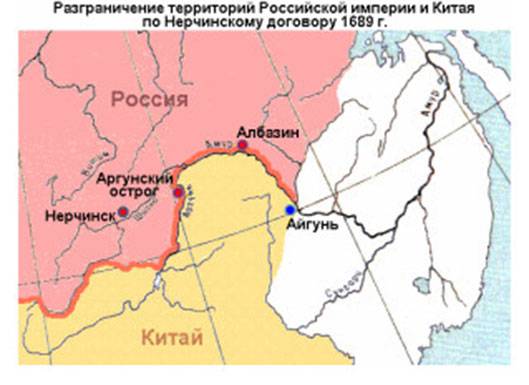
In the Nerchinsk agreement there were seven articles. The first article established the border between Russia and the Qing Empire on the Gorbitsa River - the left tributary of the Shilka River. Further, the border went along the Stanovoy Range, and the land between the Uda River and the mountains north of the Amur River remained unallocated. The second article established the border along the Argun River - from the mouth to the headwaters, the Russian territories remained on the left bank of the Argun. In accordance with the third article, the Russians were obliged to abandon and destroy the fortress of Albazin. In a special supplementary paragraph, it was emphasized that neither side should construct any structures in the area of the former Albazin. The fourth article emphasized the ban on the acceptance of defectors by both parties. In accordance with the fifth article, trade was permitted between Russian and Chinese nationals and the free movement of all persons with special travel documents. The sixth article provided for the expulsion and punishment for robbery or murder for citizens of Russia or China who crossed the border. The seventh article emphasized the right of the Manchu side to install border signs on its territory.
The Nerchinsky Treaty was the first example of streamlining relations between Russia and China. Subsequently, there was a further delineation of the boundaries of the two great states, but the agreement concluded in Nerchinsk, as if not to relate to it (and its results are still evaluated by both Russian and Chinese historians differently - as equal for the parties, and as advantageous only for Chinese side), marked the beginning of the peaceful coexistence of Russia and China.
- P P 'SЊSЏ RџRѕR "RѕRЅSЃRєRёR№
- http://www.runivers.ru/, http://mehanoid.livejournal.com/
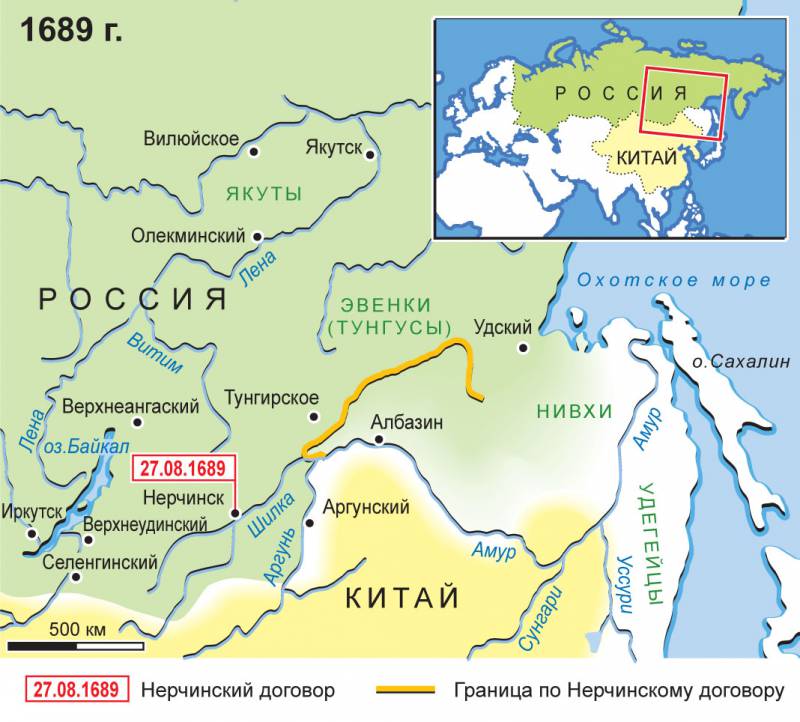
Information